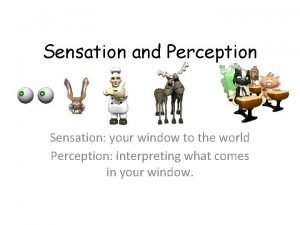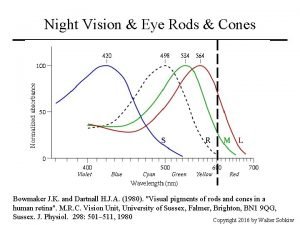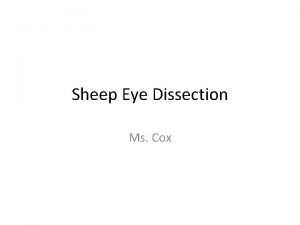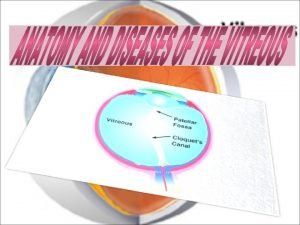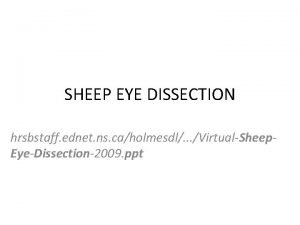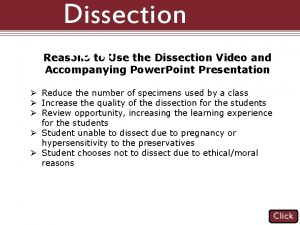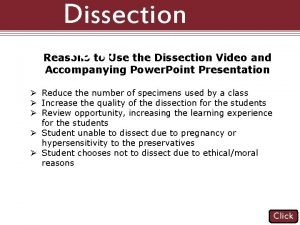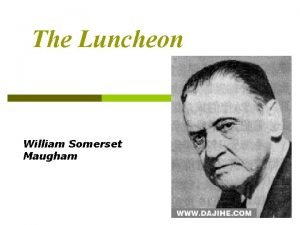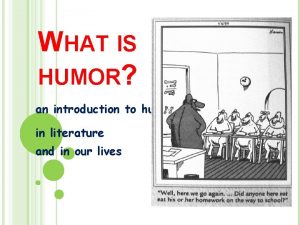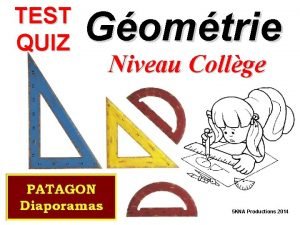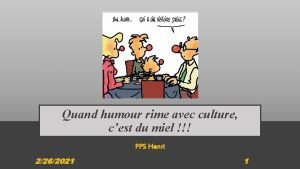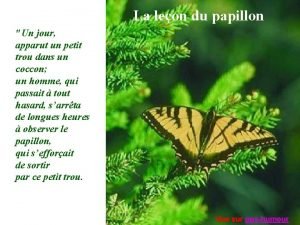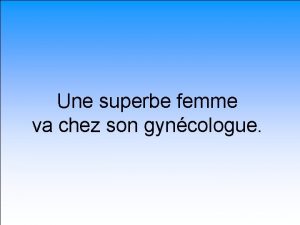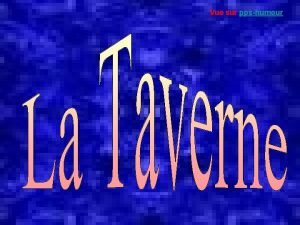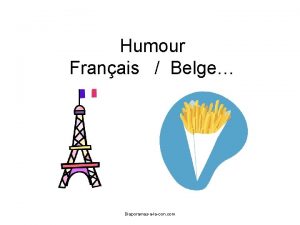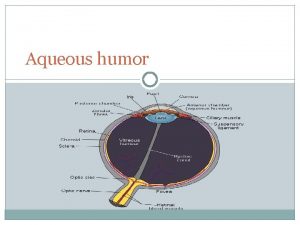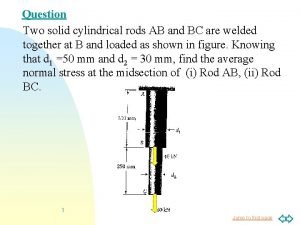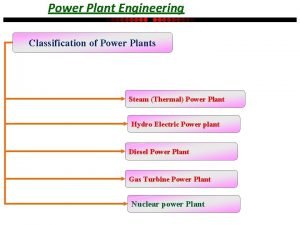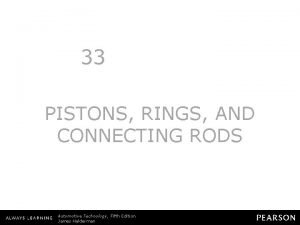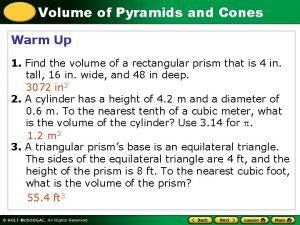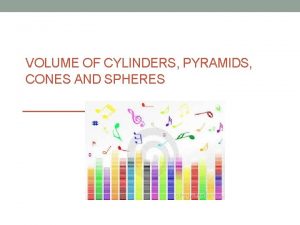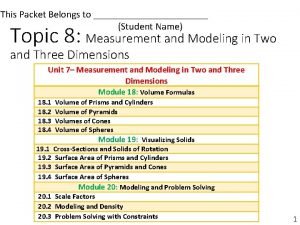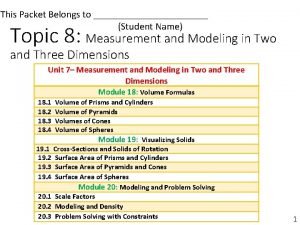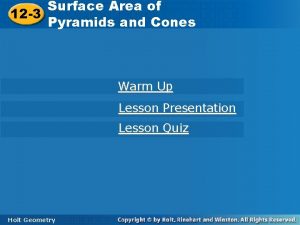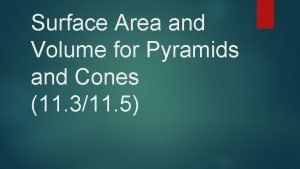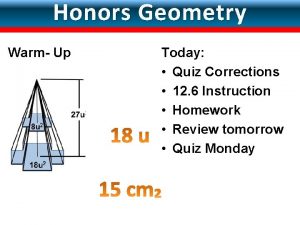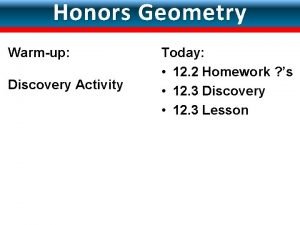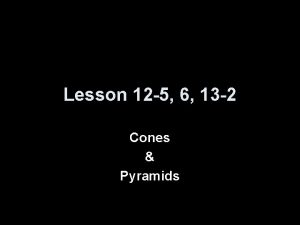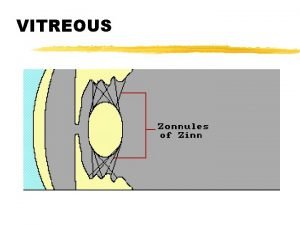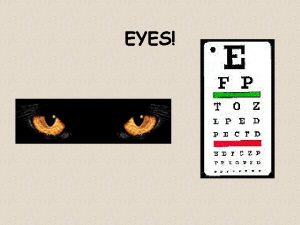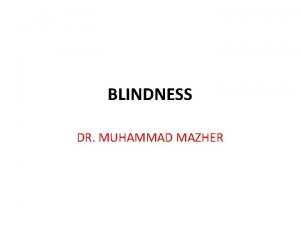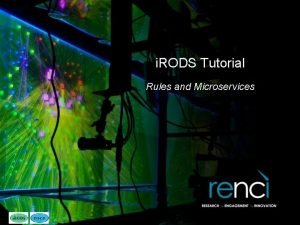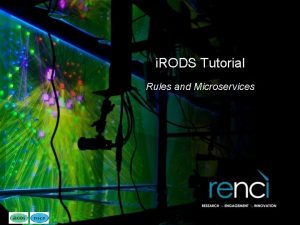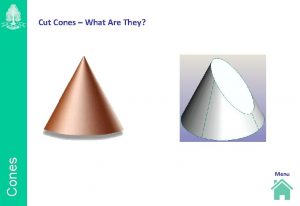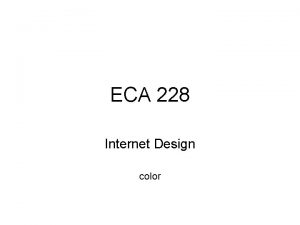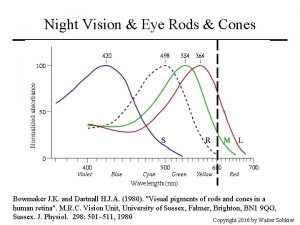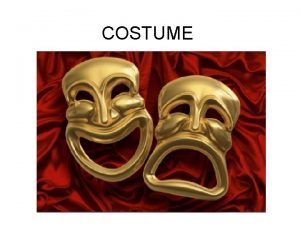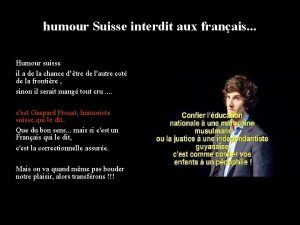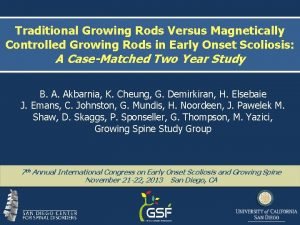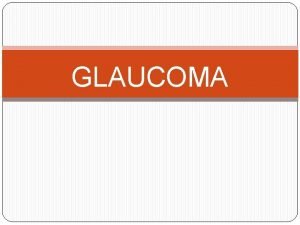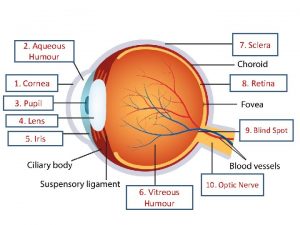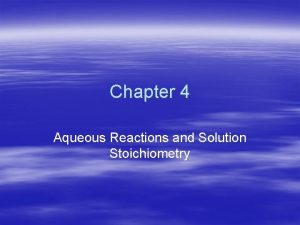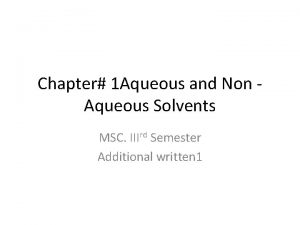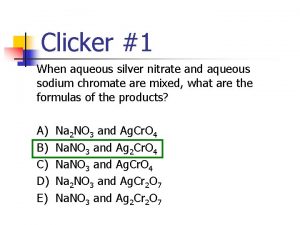Aqueous Humour Vitreous Humour Rods and cones in


























































- Slides: 58


Aqueous Humour Vitreous Humour

Rods and cones in more detail Pigment epithelium

Distinctions: Cones Rods ~ 6 million/eye ~120 million / eye -mostly in fovea -wavelength-sensitive -insensitive to light intensity -mostly in periphery -insensitive to wavelength -very sensitive to light intensity -high acuity -low acuity -few-to-one relationship to ganglions (6: 1) -many-to-one relationship to ganglions (120: 1) OK, what about transforming light into nerve impulses? (transduction)




Rods & cones are similar to typical neurons, but also different… discs

My Visual Pigment diagram Retinal opsin

My Visual Pigment diagram Retinal opsin

My Visual Pigment diagram opsin

At rest (no light): Na+ Na+ Na+

A substance called c. GMP is holding the Na+ channels open. The cascade of activity when pigment bleaching occurs results in the breakdown of c. GMP, thus closing the Na+ channels. The cell hyperpolarizes, turning off the “dark current”.

In the dark: -receptors are releasing inhibitory neurotransmitter

In the dark: -receptors are releasing inhibitory neurotransmitter In the light: -hyperpolarized receptors stop sending inhibitory signals -results in increases in AP activity bipolars, ganglions

Functional architecture or How to build a feature detector (e. g. : a length detector)

Firing rate of neuron A 7 6 5 4 3 2 1 1 2 3 4 5 6 Receptors stimulated A This way to the brain 7

-can see how differing convergence leads to differences in aspects of rods and cones: e. g. acuity differences

This way to the brain

This way to the brain

This way to the brain

This way to the brain

This way to the brain

This way to the brain

-can see how differing convergence leads to differences in aspects of rods and cones: e. g. : acuity differences e. g. 2: light sensitivity

Assume it takes 10 units of activity for a ganglion to fire This way to the brain

2 units 2 2 2 Result: No response in brain This way to the brain

102 units 10 10 10 Result: Response in brain!! This way to the brain

This way to the brain

2 units This way to the brain

2 units 2 2 2 Net activity in ganglion: 12 units This way to the brain

2 units 2 2 2 Net activity in ganglion: 12 units This way to the brain

Firing rate of neuron A 7 6 5 4 3 2 1 1 2 3 4 5 6 Receptors stimulated A This way to the brain 7

Firing rate of neuron A 7 6 5 4 3 2 1 1 2 3 4 5 6 Receptors stimulated A This way to the brain 7

Time

Firing rate Time

Firing rate Time

Firing rate Time

Firing rate of converged-on neuron

Firing rate of converged-on neuron

Problem: the firing rate is influenced by more than just orientation. Intensity of the stimulus also influences channel activity

Firing rate of converged-on neuron Notice, it fires maximally at 20 cps. So, if it is firing at 10 cps, this neuron “knows” it isn’t a vertical line. 30 25 20 15 10 5 0 But what if we used a less intense line? Is 10 cps because it isn’t vertical, or because it isn’t very intense?

Firing rate of converged-on neuron The solution: look at the pattern of activity across several differently-tuned fibres. 30 25 20 15 10 5 0 20 10 20

OK, that’s fine in theory, but what actually exists in the brain? Well, centre-surround receptive fields are everywhere Moving higher up (into cortex), can find ‘simple’ cells, complex cells, end-stopped hypercomplex cells, etc.

The processing of the signal begins at the level of the retina in the form of lateral inhibition

20% of signal

10 units -2 10 10 8 6 6 8 -2 Notice that the stronger the response, the bigger the edge enhancement will be

Cell location Response strength

Mach bands 6 4 2

Physiologically-based illusions Lateral inhibition

Also: two types of ganglions identified: Magno and Parvo cells Parvo Magno Small, numerous large, fewer Small receptive field large receptive field Slow (20 m/s) Fast (40 m/s) Sustained response Transient response Colour sensitive not colour sensitive Low contrast sensitivity high contrast sensitivity Processes form/colour Processes location, movement

From the retina, projections go to two different places: Superior Colliculus (SC) and Lateral Geniculate Nucleus (LGN) Two visual pathways: tectopulvinar, and geniculostriate

Tectopulvinar pathway LGN Pulvinar nucleus eye S. C. temporal cortex Occipital cortex

Geniculostriate pathway

Lateral Geniculate Nucleus (LGN)



See p. 85 and 86 for more diagrams
 Alex tickles his brother by stroking adjacent
Alex tickles his brother by stroking adjacent Rods and cones
Rods and cones Tonaca fibrosa occhio
Tonaca fibrosa occhio Rods and cones in eye
Rods and cones in eye Dimension of vision
Dimension of vision Texture of sheep eye lens
Texture of sheep eye lens Vitreous humor composition
Vitreous humor composition Kim lett
Kim lett Persistent hyperplastic primary vitreous
Persistent hyperplastic primary vitreous Sheep eye labeled
Sheep eye labeled Optic disc cow eye
Optic disc cow eye Label gross anatomy of cow eye
Label gross anatomy of cow eye Chaucer's humour irony and satire in the prologue
Chaucer's humour irony and satire in the prologue Character sketch of luncheon
Character sketch of luncheon Tyndall effect
Tyndall effect Chapter 15 water and aqueous systems answer key
Chapter 15 water and aqueous systems answer key Aqueous reactions and solution stoichiometry
Aqueous reactions and solution stoichiometry Homogeneous aqueous systems
Homogeneous aqueous systems Freezing point chapter 13
Freezing point chapter 13 Chapter 15 water and aqueous systems
Chapter 15 water and aqueous systems Chapter 15 water and aqueous systems
Chapter 15 water and aqueous systems What is humor
What is humor Jargon rugby
Jargon rugby Ppsmania fr humour
Ppsmania fr humour Miel rime
Miel rime Diaporama humour
Diaporama humour Papillon humour
Papillon humour Humor in waiting for godot
Humor in waiting for godot Ppsmania fr humour
Ppsmania fr humour Diaporamas sexy
Diaporamas sexy Ppsmania fr humour
Ppsmania fr humour Observational humour
Observational humour Sans rancune humour
Sans rancune humour Image silence humour
Image silence humour Humour pps adulte
Humour pps adulte Pps humour seniors
Pps humour seniors Pps humour
Pps humour Diaporama humour
Diaporama humour Watery humour
Watery humour Pps humour
Pps humour Saddam hussein
Saddam hussein Two cylindrical rods ab and bc are welded together at b
Two cylindrical rods ab and bc are welded together at b Difference between moderator and control rods
Difference between moderator and control rods Function of a connecting rod
Function of a connecting rod Protruding reinforced steel must be guarded
Protruding reinforced steel must be guarded Pistons rings and connecting rods
Pistons rings and connecting rods What is the function of connecting rod
What is the function of connecting rod Practice 10-6 volumes of pyramids and cones answers
Practice 10-6 volumes of pyramids and cones answers Volume of pyramids and cones
Volume of pyramids and cones Finding the volume of cylinders pyramids cones and spheres
Finding the volume of cylinders pyramids cones and spheres Frustum formula
Frustum formula Lesson 19-3 surface area of pyramids and cones
Lesson 19-3 surface area of pyramids and cones How to find surface area of composite figures
How to find surface area of composite figures 11-3 surface areas of pyramids and cones
11-3 surface areas of pyramids and cones Perimeter of a cone
Perimeter of a cone Surface area of pyramids and cones worksheet
Surface area of pyramids and cones worksheet 12-6 surface areas and volumes of spheres
12-6 surface areas and volumes of spheres 12-3 practice surface areas of pyramids and cones
12-3 practice surface areas of pyramids and cones Lesson 12-5 volumes of pyramids and cones
Lesson 12-5 volumes of pyramids and cones
